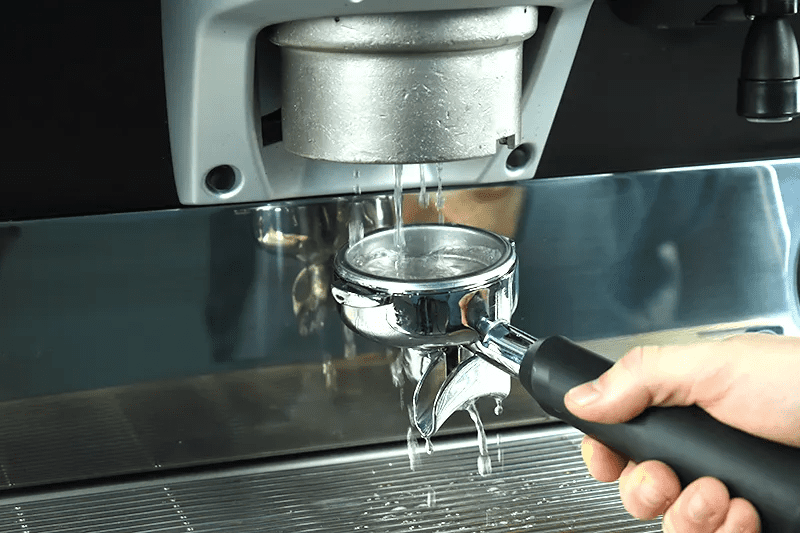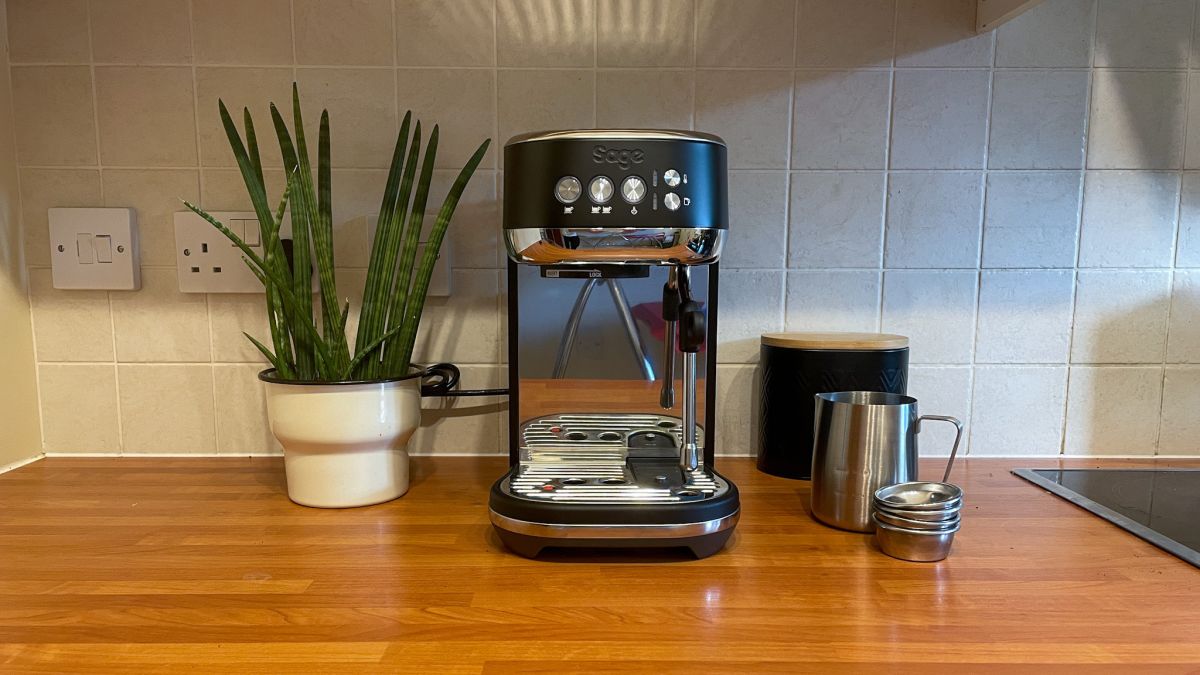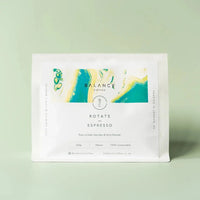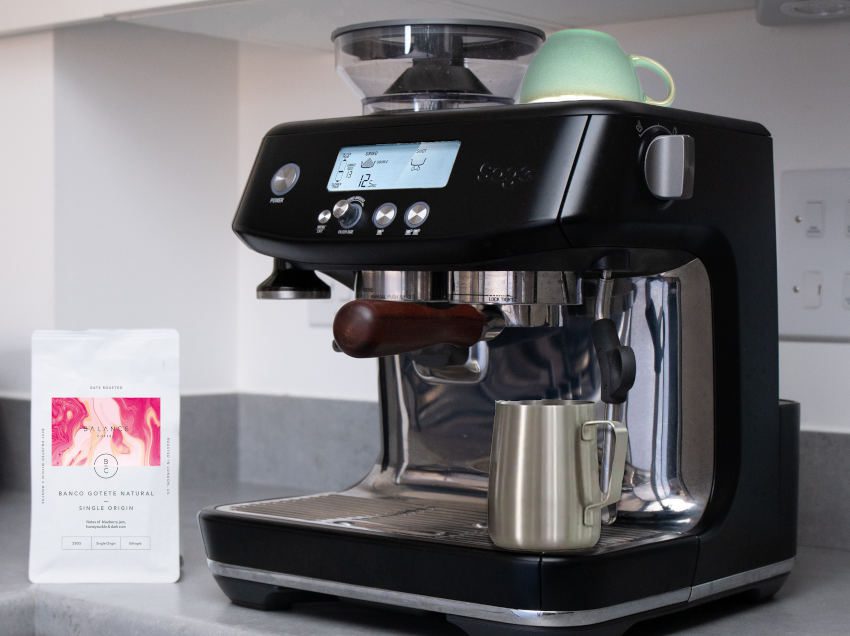In today's post, I will show you the basic coffee machine cleaning steps and how to use it to clean your sage machine.
If you own a Sage espresso machine then you're officially classified as a coffee aficionado.
But taking it to the next level and recreating that home café experience, on the other hand, requires practice and knowledge.
It is useful to learn basic coffee machine cleaning since a clean coffee machine means delicious-tasting espressos!
Giving your espresso machine the attention it needs from the beginning will also result in a prolonged lifespan saving you money in the long run.
So if you find yourself wondering “How do I clean my sage coffee machine?”, worry no more!
We've compiled a comprehensive guide to the ideal sage coffee machine cleaning procedures to allow you to take your coffee game to the next level! 
What Is A Clean Cycle In A Sage Coffee Machine?
Sage espresso machines have a built-in Sage cleaning cycle that should be used on a regular basis. When a cleaning cycle is necessary, the ‘clean me’ LED will automatically flash.
How easy can that be, right? if you are wondering, the good news is, it is that easy when you are using coffee equipment.
If you see the ‘clean me’ light flash, simply follow the steps below and consult the Sage coffee machine cleaning guide in your Sage clean me instructions manual.
- Place the cleaning disc with the Sage cleaning tablet into the portafilter.
- Assemble the drip tray, fill the tank with clean water, and secure the portafilter to the group head.
- Navigate through the menu until you reach 'Clean Cycle,' then select it by pressing the 'Manual' or 'Select' button that will be indicated
- When engaged, the espresso machine will perform an automatic back-flushing cycle, eliminating those disgusting coffee oils and mouldy coffee flavours
- When the cycle's complete, detach the portafilter and see if the cleaning pill has fully dissolved (if not, repeat the cycle).
- Thoroughly clean the portafilter handle, the basket, and the cleaning disc.
- Place the cleaning disc in the portafilter handle and back into the group head, press the 'Manual' button, and turn the machine off. Repeat this a number of times until both the tablet solution and the old coffee residues are gone.
Required Tools For Cleaning Sage Coffee Machine
To clean a Sage coffee machine, you need the following Sage Coffee Machine Cleaning tools:
- A plain plastic cleaning disc that sits within the filter of the portafilter. It's basically a circle of plastic that prevents water and cleaner from getting through the portafilter.
- A cleaning tablet is placed on the plastic disc. You can use Sage coffee machine cleaning tablets how to use them is described below, but there are many others available (Woldoclean, Urnex Cafiza and Cleona are some of the readily offered brands).
How to Clean Sage Oracle Coffee Machine?
Your Sage Coffee Machine features a proper small light that tells you when it needs to be cleaned.
To prevent any ambiguity, this light is clearly labelled "Clean Me." Even if the light is not turned on, frequent cleaning will help keep the machine and the quality of your coffee up to par.
Back-Flush Cleaning
Regular back-flush cleaning is highly recommended for excellently flavoured coffee.
The part of a coffee maker that gathers the most coffee oils, grinds, and unpleasant stale flavours is the group head.
It's as simple as that: a clean machine equals delicious espresso. To clean the group head on a regular basis and to remove old coffee particles, you can invest in a stiff coffee machine cleaning brush.
You can also save a few quids and just use your bristly old toothbrush! Place the empty cleaning disc in the portafilter and secure it to the group head.
To pressurise the basket, press the single shot button. Repeat this at least thrice for about 20-30 seconds each time to remove any remaining coffee oils or grinds.
Portafilter Handle Cleaning
It's usually a good idea to wash the portafilter with hot water from the coffee machine after usage.
If you have a kitchen sink next to the machine, you should get into the habit of using it instead of the machine.
Why? The less water that is drawn through the machine, the less money you will spend on filter replacements.
In addition, your espresso machine will survive longer. It's advisable doing a more rigorous clean on the portafilter handle every 2 weeks or so.
Soak a coffee machine cleaning tablet for 5 to 10 minutes in a jar filled with hot water.
You may also replace the shower screen if you can remove it gently by unscrewing it.
It is important to note that when you're soaking the handles, you should avoid immersing the handle in the solution as this might cause discoloration and degradation of the material.
Any regular de-tannin powder, such as puly-caff, is ideal for cleaning coffee buildup. 
Cleaning The Drip Tray
Let's be honest: the drip tray in a Sage Oracle is somewhat small and rapidly fills up.
This is expected for a coffee machine with such a compact footprint.
We've all overloaded the drip tray and had to stumble across the kitchen in an attempt to empty it, covering half of the floor in the process. To avoid this, our best recommendation is to empty the drip tray more often.
Changing The Water Filter
Limescale is a coffee machine's worst enemy, particularly if you reside in a hard water location.
In regions with a hard water problem, such as London, it's a good idea to change the filter more regularly to prevent limescale buildup. As a starting point, consider your other household appliances.
Is it necessary to descale your kettle every other week? So your filter will most likely need to be replaced more regularly.
We recommend manually descaling your coffee maker if there is significant scale residue inside the tank or outside of the unit at the hot water outlet. To do this, follow the guidelines in your handbook.
Steam Wand Maintenance
When learning how to clean a Sage Oracle, one of the most important parts to clean is the steam wand. It's good practice for when you're making milk-based coffees.
Always purge after each steam and then clean with a milk towel. If you maintain this practice you will never have problems with your Sage Oracle's steam handle.
Milk and milk replacements aren't the best when heated, so letting milk solidify on your steam wand is asking for trouble.
Steam wands serve like a suction, and milk drops will find their way into your machine, fermenting and clogging the pipes if you're not careful!
If your machine's steam handle becomes clogged after descaling, please contact Sage for assistance.
They also provide excellent after-sales and warranty support, so we chose them as our equipment partner.
How to Clean Sage Barista Express Coffee Machine?
It's tempting to get too thrilled and start using your new Sage Barista Express right away. And you'll immediately see that things may get out of hand. So, here's a brief set of instructions for cleaning a sage coffee machine to help you in your Sage barista cleaning. We recommend going through the Sage barista express cleaning cycle at least once a month to keep your espresso machine spick and span! 
Cleaning The Water Drip Tray
When the "empty me" light displays, it's time to clean the entire drip tray. Simply pull it using the bottom cut-out handle.
You'll note that lifting the front tray will also pull out the back tray. Remove the front tray and empty the contents into the sink.
Then, disassemble the three sections that make up the front tray and give them a quick clean-down.
You can also place a folded microfibre on top of your drip tray to prevent it from becoming dirty. This prevents coffee from spilling into the water drip tray while making.
Cleaning The Portafilter
Every few weeks, take the time to clean the portafilter thoroughly. You'll notice that filth and coffee residue accumulate around the metal part that separates the coffee when it's pouring out. Just unscrew this to access the panel behind and clean thoroughly.
Cleaning The Milk Frother
The simplest approach to cleaning the milk frother is to clean it as you go. After you're done steaming the milk, use a piece of microfiber cloth to run the steam for around 5 seconds. Fold the cloth in half and use caution - the steam is super hot! If you're wondering how to effortlessly remove the dried-on milk on your milk frother, simply point the wand over the drip tray hole and start the steam for around 30 seconds. That should take care of it! 
Cleaning The Knock Box
This is the small tray/box where you dump your used coffee grinds. Make it a point not to leave it for longer than three days before cleaning. The reason for this is that, while it isn't overflowing, it does rapidly become mouldy. After emptying the box into the dustbin, just run it under the tap for a few seconds (all of the grounds should come out without wiping/ scrubbing), and then put it upside down to dry.
How to Clean Sage Barista Pro Coffee Machine?
After each usage, the Sage Barista Pro cleaning cycle must be run. This includes the most often used parts, such as the portafilter, group head, steam wand, and filter basket. Other parts must be cleaned on a regular basis, which can range from days to weeks depending on how many espressos you prepare every day.
How to Clean Barista Pro’s Group Head
Purging the Barista Pro's group head before and after each shot is the best method to keep it clean. To purge your coffee maker's group head, insert a portafilter with a clean filter basket in the group head, push the two-cup button, and let the water flow for a few seconds to rinse any residue coffee. To turn off the water, press the two-cup button again. When you're finished purging, wash the portafilter and basket with warm water to remove any remaining coffee.
How to Clean Barista Pro’s Portafilter and Filter Basket
After each usage, the Barista's portafilter and filter basket need to be cleaned. Rinse the portafilter and filter basket with hot water to get rid of any leftover coffee oils. This method may also be carried out under the running group head. If any of the filter basket pores remain blocked, use the Breville cleaning tool's pin to clear them. Sage also warns against using a dishwasher to clean the Barista Pro's filter basket and a portafilter. Dishwashers may corrode the metal, and certain detergents may affect the portafilter housing's materials. 
How to Clean the Steam Wand?
Clean the steam wand with a moist towel first, then purge for a few seconds. Place the steam handle over the drip tray, rotate the STEAM dial to steam, and wait a few seconds for the machine to generate steam. Finally, return the STEAM dial to its default position.
Cleaning the Drip Tray
Take the drip tray out of the machine, remove the top sections (the plastic cover and the metal grill), and drain the water. After that, wash the drip tray by scrubbing it with a soft cloth in tepid soapy water and rinsing it well. Sage recommends completely drying all parts before putting the drip tray together and installing it in the machine.
How to Clean Sage Bambino Coffee Machine?
It's easy to overlook how dirty coffee oils can leave these machines. Ultimately, regularly running the Sage bambino cleaning cycle can protect the machine from breaking down in the future. 
Cleaning The Water Drip Tray
Your Bambino will store around 200ml of water before needing to be emptied. The Bambino, unlike the Barista Express and some of the bigger Sage coffee machines, does not have the small "empty me" indicator; instead, it has a little red plastic notch that goes up with the water level. When the red notch goes up, it's time to empty the drip tray. While you're at it, it's a good idea to remove the metal upper half and clean the plastic tray beneath. Not only will this fill with condensation from within the machine, but it will also fill with drops of milk and coffee that must be removed on a regular basis.
Cleaning The Portafilter
The portafilter on the Bambino is a little tough to clean. It comes with a little plastic inlay. To avoid breaking it while cleaning, immerse the portafilter in a jug of tepid water and a dissolved Sage coffee maker cleaning tablet.
Cleaning the Milk Frother/ Steam Wand from Dried Milk
This is probably the most difficult step of cleaning the Sage Bambino since milk may become very hard to remove after it has dried. To avoid having to spend time cleaning the steam handle, use a microfiber cloth to massage the end of the steam wand while pushing the steam lever to trigger the steam immediately after heating milk. This will quickly remove the last of the milk on the handle and will also cleanse the bottom, ejecting any particles of milk that have gotten within the wand's bottom.
How to Clean Sage Flush Coffee Machine?
You will need the following items to conduct the Sage flush cleaning cycle:
- Cleaning Disc
- 1 Cup Single Wall Filter Basket
- Cleaning Tablet
Here is a step-by-step guide for flushing a Sage coffee maker
- Place the filter basket in the portafilter
- Insert the cleaning disc in the filter basket
- Place the cleaning tablet on the disc
- Secure the group head and the portafilter
- Drain the water tray
- Fill the water tank
- From the menu, select flush
- Press the one cup button and wait for five minutes
- Remove the portafilter
- Repeat the process if you notice the cleaning tablet hasn’t fully dissolved

Frequently Asked Questions
How do I clean my Oracle coffee maker?
To prevent any ambiguity, this light is clearly labelled "Clean Me." If you see this light flashing, follow the steps in the article. If you’re wondering “What toolset do I need to clean a sage coffee machine?”, you should purchase one of the Sage coffee machine cleaning kits. These Sage Coffee Machine Cleaning products are available for the Sage coffee makers.
How often should I clean my sage coffee machine?
Cleaning and maintenance include all components of your coffee maker, from cleaning the group head and milk frother to replacing the water filter and descaling on a regular basis. How often to clean sage coffee machine primarily depends on the Sage coffee maker variant you own and how often you use it.
How do you clean Sage Group Heads?
Just put a teaspoon full of cleaner on top of the blind filter before running a flush cycle. Run the group a few times in 10-second intervals. After back-flushing with a de-tannin powder, detach the coffee lever and run the group once again to rinse out any extra cleaner.
Where is the sage cleaning disc?
To clean your machine, you will need the Sage plastic cleaning disc, which goes within the filter of the portafilter. It's simply a circle of plastic that prevents water and cleaner from flowing through the portafilter. The cleaning tablet is placed on this disc.
How do I clean my sage Oracle steam wand?
After using the Sage Oracle steam wand, wipe it down well with a moist towel and lower it to purge automatically. This prevents burned milk from developing on the exterior and should be done after each usage, including in between coffee brewing sessions.
How do you clean an espresso arm?
To clean your espresso arm, combine a touch of acid, such as a wedge of lemon peel or a few drops of regular vinegar, with hot water. Soak for about five minutes, and the milk crud should be gone.
What does flush mean on Sage coffee machine?
The FLUSH indicator on a Sage coffee maker indicates that the flush cleaning cycle, also known as the backflush, is required. This cycle removes oil residue from the group head.
How do you backflush Sage Bambino?
The Sage Bambino cannot be backflushed. This is because the Bambino lacks a three-way solenoid valve, and only espresso machines with a solenoid can be backflushed.
Conclusion
So there you have, everything you need to know about sage coffee machine cleaning. It’s over to you now! What other sage coffee machine cleaning method did we not cover in this article? Use the comment box to leave us your thoughts and we will be sure to add that in our next update. Having said that, if you like this post please share it on Facebook, Instagram, or Twitter. We hope we covered all the questions you had about cleaning Sage coffee machines. If you have more, check out Sage FAQs here. And lastly, you need to try out our coffee subscriptions that guarantee you will have one of the best coffee drinking experience ever.














